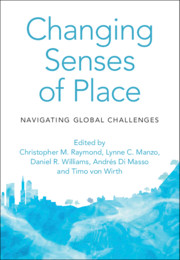Book contents
- Changing Senses of Place
- Changing Senses of Place
- Copyright page
- Dedication
- Contents
- Contributors
- Foreword
- Preface
- Acknowledgements
- Introduction
- Part I Climate Change and Ecological Regime Shifts
- 1 Coral Reef Collapse and Sense of Place in the Great Barrier Reef, Australia
- 2 Navigating the Temporalities of Place in Climate Adaptation
- 3 The Place–Subjectivity Continuum after a Disaster
- 4 Changing Sense of Place and Local Responses to Bengaluru’s Disappearing Lakes
- 5 Place-Making for Regional Conservation
- Part II Migration, Mobility and Belonging
- Part III Renewable Energy Transitions
- Part IV Nationalism and Competing Territorial Claims
- Part V Urban Change
- Part VI Technological and Legal Transformations
- Part VII Design and Planning Strategies for Changing Senses of Place
- Part VIII Conclusion
- Index
- References
1 - Coral Reef Collapse and Sense of Place in the Great Barrier Reef, Australia
from Part I - Climate Change and Ecological Regime Shifts
Published online by Cambridge University Press: 15 July 2021
- Changing Senses of Place
- Changing Senses of Place
- Copyright page
- Dedication
- Contents
- Contributors
- Foreword
- Preface
- Acknowledgements
- Introduction
- Part I Climate Change and Ecological Regime Shifts
- 1 Coral Reef Collapse and Sense of Place in the Great Barrier Reef, Australia
- 2 Navigating the Temporalities of Place in Climate Adaptation
- 3 The Place–Subjectivity Continuum after a Disaster
- 4 Changing Sense of Place and Local Responses to Bengaluru’s Disappearing Lakes
- 5 Place-Making for Regional Conservation
- Part II Migration, Mobility and Belonging
- Part III Renewable Energy Transitions
- Part IV Nationalism and Competing Territorial Claims
- Part V Urban Change
- Part VI Technological and Legal Transformations
- Part VII Design and Planning Strategies for Changing Senses of Place
- Part VIII Conclusion
- Index
- References
Summary
Given global social and environmental change, understanding how resulting place change affects people–place bonds is of pressing importance. However, given traditional views of these bonds as static, understanding the fluidity of people’s relationship with place remains nascent. We examine how people’s sense of place relating to Australia’s Great Barrier Reef changed over a four-year period during which the reef suffered climate-change-induced mass coral bleaching. Operationalising sense of place with seven indicators representing place attachment, identity and meanings, we found increases in attachment, identity and two meanings (pride, biodiversity) and decreases in three meanings (lifestyle, aesthetics, scientific value). We suggest that place change heightened the emotional and intangible elements of sense of place, while having a negative effect on the more instrumental meanings. Our results challenge a notion of people–place bonds premised on fixity, stability, and low dimensionality, instead suggesting the need to consider them as dynamic and multidimensional.
Keywords
- Type
- Chapter
- Information
- Changing Senses of PlaceNavigating Global Challenges, pp. 21 - 31Publisher: Cambridge University PressPrint publication year: 2021

